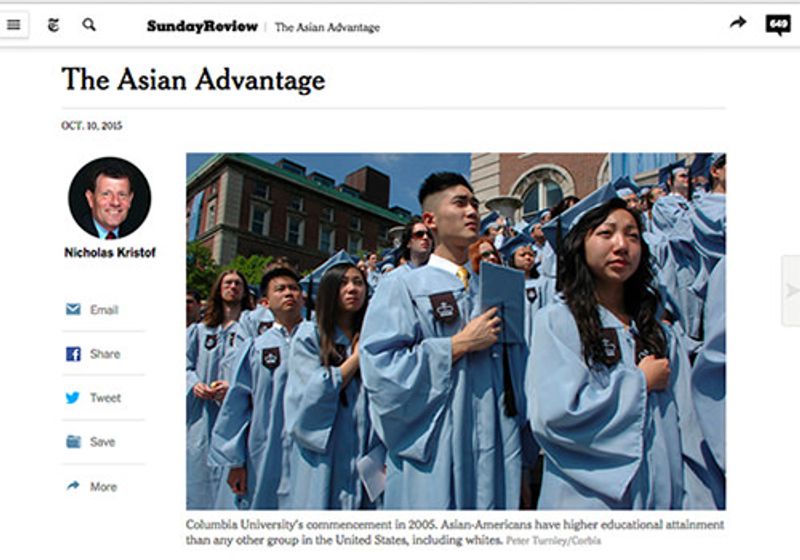Blog
Nick Kristof’s distasteful reframing of the model minority as “The Asian Advantage” in the New York Times
When the presidential candidates square off and debate in this campaign, I hope they don’t think Asian Americans are such “success stories” they can simply write us off when it comes to public policy.
And I hope someone doesn’t point to us and say, Asian Americans are the “good example” or, heaven forbid, the “Model Minority.”
You never know. They may have read The New York Times.

If you’re still buzzing about Nicholas Kristof’s “The Asian Advantage” in Sunday’s New York Times, I don’t blame you.
Talk about a major infusion of positive stereotype re-enforcement!
We didn’t need it. And, of course, it’s wrong. It’s Kristof, a Tiger Dad by marriage, letting us know his stripes–about how he feels about us Asian Americans.
But he doesn’t want to roar too loudly as a Caucasian guy, and even acknowledges the awkwardness of his initial question, “Why are Asian Americans so successful in America?”
Maybe it’s because he knows that despite the Census data for income and educational attainment (We’re No.1), it’s unwise to use such a broad brush when it comes to generalizing about Asian American success.
Income is often misleading due to the large numbers of earners in an Asian American household. It’s even more misleading when you break down the numbers by ethnicity. Disaggregate the dozens of Asian ethnicities in the U.S. and the poverty rates are astonishingly high for Southeast Asians (Hmong Americans, 37.8 percent; Cambodian Americans, 29.3 percent; and Laotian Americans, 18.5 percent). If poverty is success (as I suppose it might be for, say, a priest or monk), then I guess those numbers are consistent with the assumptions of Kristof’s basic question.
But what bothers me is his provocative corollary set-up question, which reframes the old “Model Minority” discussion in a new, slightly less offensive way: “Does the success of Asian Americans suggest that the age of discrimination is behind us?”
If Asian Americans have discovered the secret to the end of discrimination, that would be right up there with driving in the historic Golden Spike!
Indeed, if we held some formula for success, that might make us the new post-racial exemplars for all non-successful types. (Oh, you mean people of color, perhaps?) Maybe even someone Kristof describes at the end of his column could benefit, such the “black boy in Baltimore who is raised by a struggling single mom, whom society regards as a potential menace.”
It’s a ridiculously offensive line, laced with that old-fashioned model minority mindset. But that’s what Kristof’s “Asian Advantage” is about–an attempt to lend credence to a tired iconic stereotype.
Here’s what Asian Americans really know to this day: Not all Asian Americans are successful, and even successful Asian Americans know discrimination isn’t over. Ask the Harvard grad who can’t a job in his field. The bamboo curtain bends but doesn’t break.
That’s the ironic thing about the new scholarly work Kristof cites in his column.
“The Asian American Achievement Paradox,” by sociologists Jennifer Lee and Min Zhou, was intended to be an antidote to the hard cultural stands that commentators like Kristof on both the left and the right are fond of taking to explain Asian American success. A little nuance is better, right?

Lee and Zhou write that these commentators focus on cultural traits, values, attitudes and behavioral patterns as “fixed and essential to ethno-racial groups.” Ignored are the structural factors in society that affect educational attainment: “the effects of ethno-racial stereotypes, implicit biases, and microaggressions–the brief, commonplace verbal, behavioral, and institutional indignities imposed on marginalized ethno-racial groups.”
That, folks, is what we non-academics would call modern, everyday racism.
Lee and Zhou’s research is based on 82 in-depth interviews with Chinese and Vietnamese immigrants in Los Angeles.
And though Kristof cites the book, he does it a tad selectively.
For example, Lee and Zhou on page 169 of their tome come away with this strong conclusion about Asian American success that Kristof gives short shrift:
“The Asian American success frame is so constricting only a very small minority attain it,” write Lee and Zhou. “Based on our in-depth interviews, we found that most 1.5- and second-generation Chinese and Vietnamese did not achieve the success frame and that many did not come even close.”
Far from stories of Asian success, the authors found some interviewees who had not graduated from college or “languished” until they ultimately graduated beyond four years. Some just dropped out.
Behind the success stories are these real stories that form a new invisible Asian American–the kind that most want to deny really exist.
“Their stories, while not atypical, go unnoticed and unremarked upon by their immigrant parents, other immigrant children, their ethnic communities, the American mainstream media, and even social scientists,” Lee and Zhou write.
“Because these disconfirming narratives remained behind the veil, the cases of these immigrant children seemed like exceptions to Asian American exceptionalism. So strong is the perception that the success frame is normative for Asian Americans that the 1.5-second generation Chinese and Vietnamese who could not attain it, or who chose to forego it altogether, find themselves at odds with their immigrant parents, their coethnics, and their ethnic identities.”
That nuance of Lee and Zhou’s work is lost from reading Kristof’s column.
So how did Asian American achievers become successful? Lee and Zhou say much of it is due to the kind of immigrants who have come here since the Immigration and Naturalization Act of 1965. When the racist quotas of the past were finally lifted, the people who came weren’t your typical early immigrants. Post-65s were all self-selected, prone to education and new world success. And when they sought opportunity in the U.S., Lee and Zhou say they used the social capital in their community networks to succeed.
That’s it. That’s the real Asian advantage.
The social capital and being around other Asians explain our success, not comparing ourselves to non-Asians.
“Before proceeding, we add an important caveat and word of caution,” write Lee and Zhou. “Our study focused on the children of Chinese and Vietnamese immigrants in Los Angeles, where ethnic communities are sizeable, ethnic capital is abundant, and strong ethnic economies create tangible and intangible resources.”
That may explain why refugee communities in far-flung places in the Midwest may not do as well as other Asian groups.
“Lacking ethnic capital in their communities (or lacking ethnic communities altogether), poor and working-class Asian immigrants and their children must rely exclusively on publicly available resources in non-metropolitan areas,” write Lee and Zhou.” With no access to ethnic resources, their prospects for mobility may be just as precarious as those of working-class children from non-Asian and non-hyper-selected ethno-racial backgrounds. We should not turn a blind eye to this segment of the Asian American population, nor can we ignore poor Asian American groups like Cambodians, Laotians, and Hmong, who drop out of high schools at higher rates than African Americans and Latinos. Public policies should not ignore the children of Asian immigrants from whom supplemental resources are out of reach, especially in those environments were these additional resources are critical to attaining intergenerational mobility.”
Read that passage in Lee and Zhou’s book and you realize the questions posed in Kristof’s piece are just a phony pose.
Nice of him to quote from some of Lee and Zhou’s work, but he misses their point if all he wants to do is reframe the model minority debate and restate his own cultural bias–that “success of Asian Americans is a tribute to hard work, strong families and passion for education. Bravo!”
Yeah, that’s part of it. But sometimes hard work doesn’t produce success. Only more sweat and often frustration.
But since Kristof wants to be seen as a liberal good guy, he does get back to this bottom line: “Let’s not use the success of Asians to pat ourselves on the back and pretend that discrimination is history.”
Funny, I don’t see anyone who knows how hard it is to be Asian American–especially in non-traditional fields for Asian Americans like the media, the arts, or politics–patting himself on the back thinking discrimination is finis.
No, for that, it takes the positive action that has always changed society: public policy and legislative changes, such as the lifting of racist immigration quotas, the ending of anti-miscegenation laws, and the repeal of laws forbidding property ownership. And yes, the preservation of affirmative action to provide diversity in schools and the workplace.
That’s where the hard work still remains to be done and the reason it’s important to hear someone in the upcoming campaign address Asian Americans as more than a stereotype.
But we won’t get what we all need if people buy into the views of the Tiger Moms and Dads blinded by their own success.

Emil Guillermo is an independent journalist/commentator. Updates at www.amok.com. Follow Emil on Twitter, and like his Facebook page.
The views expressed in his blog do not necessarily represent AALDEF’s views or policies.
Read Emil's full bio →